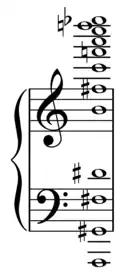Elektra chord
The Elektra chord is a "complexly dissonant signature-chord"[1] and motivic elaboration used by composer Richard Strauss to represent the title character of his opera Elektra that is a "bitonal synthesis of E major and C-sharp major" and may be regarded as a polychord related to conventional chords with added thirds,[2] in this case an eleventh chord. It is enharmonically equivalent to a 7#9 chord : D♭-F-A♭-C♭-E and a 6b9 chord : E-G#-B-C#-F.


| Component intervals from root | |
|---|---|
| diminished fourth | |
| minor second | |
| diminished seventh | |
| perfect fifth | |
| root | |
| Forte no. / | |
| 5-32 / |
In Elektra the chord, Elektra's "harmonic signature" is treated various ways betraying "both tonal and bitonal leanings...a dominant 4/2 over a nonharmonic bass." It is associated as well with its seven note complement which may be arranged as a dominant thirteenth[1] while other characters are represented by other motives or chords, such as Klytämnestra's contrasting harmony. The Elektra chord's complement appears at important points and the two chords form a 10-note pitch collection, lacking D and A, which forms one of Elektra's "distinctive 'voices'"[3]

The chord is also found in Claude Debussy's Feuilles mortes, where it may be analyzed as an appoggiatura to a minor ninth chord, and Franz Schreker's Der ferne Klang, and Alexander Scriabin's Sixth Piano Sonata.[2]
References
- Lawrence Kramer. "Fin-de-siècle Fantasies: Elektra, Degeneration and Sexual Science", Cambridge Opera Journal, Vol. 5, No. 2. (Jul., 1993), pp. 141-165.
- H. H. Stuckenschmidt; Piero Weiss. "Debussy or Berg? The Mystery of a Chord Progression", The Musical Quarterly, Vol. 51, No. 3. (Jul., 1965), pp. 453-459.
- Carolyn Abbate, 'Music and Language in Elektra', in Richard Strauss: Elektra, ed. Derrick Puffett, Cambridge Opera Guides (Cambridge, 1989), 107-27. Cited in Kramer (1993), p.156.
